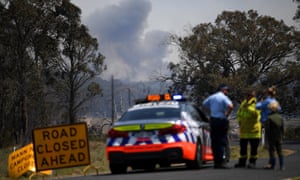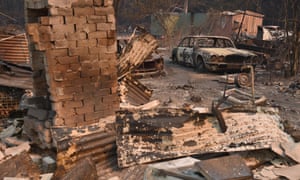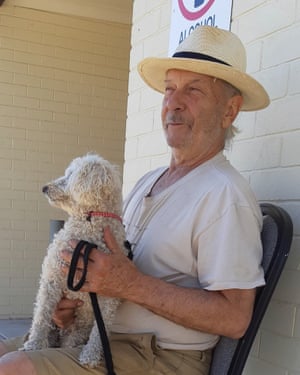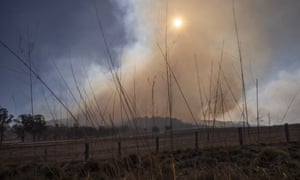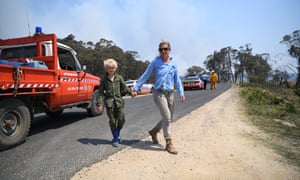The greater Sydney region will face catastrophic fire danger on Tuesday for the first time since the rating was introduced and fire authorities say conditions in other parts of New South Wales could also be set to worsen.
The warning was issued as more than 80 fires continued to burn in the north of the state late on Sunday.
Three people have died in the fires and at least 150 properties have been destroyed. The number of properties lost in the emergency is expected to grow as fire grounds become accessible to crews assessing the damage.
On Sunday afternoon, two emergency warnings were issued for fires burning on the north-east and mid-north coast of NSW.
A fire at Bills Crossing, north of Taree, had already burned through almost 12,000 hectares, with the Rural Fire Service warning people in the Johns River area to seek shelter as the blaze approached.
The other warning was issued for an out-of-control fire in the Mt Nardi national park, where people were advised that leaving early was their safest option.
While some weather conditions were expected to ease late on Sunday and into Monday, both the Rural Fire Service and the Bureau of Meteorology warned that dangerous conditions were forecast for Tuesday.
The Rural Fire Service issued a catastrophic fire danger warning for the greater Sydney and greater Hunter regions – including the Blue Mountains and the central coast – on Tuesday due to high temperatures, strong winds and dry conditions.
Extreme fire danger is forecast in the Illawarra/Shoalhaven region, the north coast, the central ranges, the northern slopes and the north-western regions.
The far north coast, New England, the far south coast, the southern ranges, and the lower central west plains are expecting severe fire danger.
The prime minister, Scott Morrison, and the NSW premier, Gladys Berejiklian, visited devastated bushfire communities on Sunday.
The federal government announced that disaster recovery payments of $1,000 per adult and $400 per child would be made available immediately through Centrelink for people affected by fires in NSW and Queensland.
Leo Generaux from Tinonee, about 12km south-west of Taree, said on Sunday he didn’t know if he had a house to return to.
He and his wife had been evacuated twice in three days and had been told his neighbour’s home had been destroyed.
On Sunday, Generaux, aged in his 70s, was at the Club Taree evacuation centre watching for the arrival of Morrison and Berejiklian.
“We were allowed to go in on Saturday to see our home and our neighbours, waiting at our door, told us their house had been burnt to the ground. We were in a state of shock,” he said.
“We said, ‘You can stay with us,’ but they said, ‘That’s no good the fire hasn’t finished yet,’ and then in the afternoon we were evacuated again. There was a fire on the other side, the east side.
“The smoke was billowing towards us and we got the phone call, ‘Leave now’. I have no idea if my house is still there. We left in a hurry, only one road was open. That’s now closed. There is no way of telling what is going on at our property.”
In Terania Creek, near the Nightcap national park, Terri Nicholson spent Sunday watching fires move into private property on the western side of the valley and start heading south. Many residents in the immediate vicinity of multiple fires had been evacuated to The Channon, the nearest town.
Nicholson’s parents are Nan and Hugh Nicholson. Forty years ago they hosted the blockade that ultimately stopped logging of the rainforest near their property and saved rainforest in other parts of NSW.
“Nan and Hugh Nicholson hosted the site of the Terania protest to defend this great rainforest from logging and now we’re here defending it due to the effects of climate change,” Nicholson said from her parents’ property.
Quick guide
Climate change and bushfires

The link between rising greenhouse gas emissions and increased bushfire risk is complex but, according to major science agencies, clear. Climate change does not create bushfires, but it can and does make them worse. A number of factors contribute to bushfire risk, including temperature, fuel load, dryness, wind speed and humidity.
The Bureau of Meteorology and the CSIRO say Australia has warmed by 1C since 1910 and temperatures will increase in the future. The Intergovernmental Panel on Climate Change says it is extremely likely increased atmospheric concentrations of greenhouse gases since the mid-20th century is the main reason it is getting hotter. The Bushfire and Natural Hazards research centre says the variability of normal events sits on top of that. Warmer weather increases the number of days each year on which there is high or extreme bushfire risk.
Dry fuel load - the amount of forest and scrub available to burn - has been linked to rising emissions. Under the right conditions, carbon dioxide acts as a kind of fertiliser that increases plant growth.
Dryness is more complicated. Complex computer models have not found a consistent climate change signal linked to rising CO2 in the decline in rain that has produced the current eastern Australian drought. But higher temperatures accelerate evaporation. They also extend the growing season for vegetation in many regions, leading to greater transpiration (the process by which water is drawn from the soil and evaporated from plant leaves and flowers). The result is that soils, vegetation and the air may be drier than they would have been with the same amount of rainfall in the past.
The year coming into the 2019-20 summer has been unusually warm and dry for large parts of Australia. Above average temperatures now occur most years and 2019 has been the fifth driest start to the year on record, and the driest since 1970.
“I don’t even have the words right now. It’s just gobsmacking and distressing to witness.”
Nicholson said residents were preparing for conditions to worsen over the next few days.
“We’re seeing rainforest burn. There’s fire threatening our houses right now,” Nicholson said.
“There’s fire trucks, volunteers. The local fire service is incredible, they’re protecting our home. This is the home I grew up in. My childhood home. My parents’ land.
“It’s quite intense to see ancient, iconic rainforest burn – this delicate ecosystem – and see firefighters here risking their lives and just to see global heating in action.”
In Queensland, more than 50 fires were burning on Sunday and emergency warnings were still in place at Cooroibah and Ringtail Creek, north of Noosa on the Sunshine Coast.
Fires had destroyed houses, sheds and cars and forced thousands of people to flee their homes.
A firefighter suffered a broken leg but no lives have been lost or other injuries reported.
The winds and hot and dry conditions that have stoked blazes are set to continue on Sunday, ease on Monday, and worsen on Tuesday, challenging crews and people battling to save their homes.
The emergency warnings for Cobraball and nearby Bungundarra have eased but people are warned to be on the alert because conditions could get worse.
They face an anxious wait to see if their homes are still standing because they can’t return until it is safe to do so.
Red Cross Queensland’s emergency services manager, Colin Sivalingum, said it was a traumatic time for people in evacuation centres.
“Most people just want to go back home to see what’s actually happening. That’s making them very anxious. That’s what they’re telling us,” he told the ABC.
• Additional reporting by Australian Associated Press
